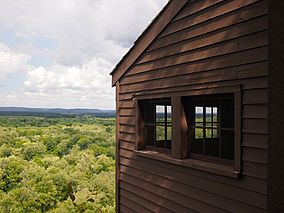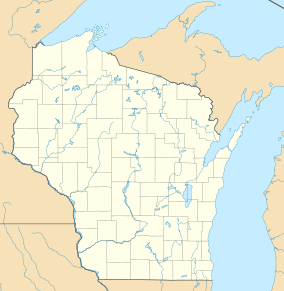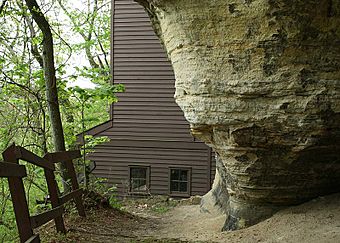Tower Hill State Park facts for kids
Quick facts for kids Tower Hill State Park |
|
|---|---|
|
IUCN Category V (Protected Landscape/Seascape)
|
|

The shot tower overlooking the Wisconsin River Valley
|
|
| Location | Iowa, Wisconsin, United States |
| Area | 77 acres (31 ha) |
| Established | 1922 |
| Governing body | Wisconsin Department of Natural Resources |
Tower Hill State Park is a fun place to visit in Wisconsin, United States. It's famous for its old Helena Shot Tower. This tower was built a long time ago, in 1832, and was used to make lead shot until 1860. The park is right next to the Wisconsin River, a beautiful river that flows through the state. The shot tower is so important that it was added to the National Register of Historic Places in 1973.
Contents
The Park's Natural Beauty
The tall cliffs along the Wisconsin River are made of a type of rock called Jordan Sandstone. This park is in a special area called the Driftless Area. This means it was never covered by ice during the ice ages, unlike most of the Midwest. Because of this, the land here looks different, with steep hills and deep valleys.
Back in the 1800s, the Wisconsin River flowed right at the bottom of these cliffs. Over time, the river moved a little. Now, a small stream called Mill Creek forms the northern edge of the park.
How Shot Towers Work
Have you ever wondered how tiny, round lead balls for old guns were made? It's pretty cool! Shot towers use a clever trick involving how liquids behave when they fall. This method was invented in 1782.
Here's how it works:
- Melted lead is poured through a special screen at the very top of a tall tower or shaft.
- As the lead droplets fall, they naturally form into perfect little spheres because of something called surface tension.
- The droplets cool down and harden into these round shapes as they drop.
- At the bottom, the tiny lead balls land in a basin of water. This breaks their fall and helps them cool completely.
Building the Helena Shot Tower
In 1830, a smart businessman named Daniel Whitney was traveling along the Wisconsin River. He saw a sharp cliff near a town called Helena and thought it would be a perfect spot for a shot tower. Why? Because lead had just been found nearby in Iowa County.
The cliff itself had a 60-foot (18-meter) straight drop. Below that, the sandstone cliff sloped down to the riverbank, which was 180 feet (55 meters) below the top of the cliff. Whitney started a company called the Wisconsin Shot Company. He put his employee, John Metcalf, in charge of building the tower.
The Amazing Tunnel Digger
The 60-foot cliff was a great start, but Metcalf needed someone to dig a shaft for the remaining 120 feet (37 meters) down to the ground. Also, to get to the bottom of the shaft where the lead shot would be collected, they needed a 90-foot (27-meter) horizontal tunnel.
In 1831, a 22-year-old lead miner named Thomas B. Shaunce was hired for this tough job. Shaunce worked mostly by himself, sometimes getting help from a friend, Malcom Smith. They used pickaxes and a gad (a type of chisel). They even used gunpowder to break up the harder rock deeper down.
Shaunce was very precise. He used a plumb-bob (a weight on a string) to make sure the shaft was perfectly straight. He used a windlass (a machine for lifting) to pull out the broken rock. To figure out where to start digging the horizontal tunnel from the riverbank, he stood across the water and aimed his rifle directly below the top of the shaft!
When Shaunce finally broke through from the horizontal tunnel to the bottom of the shaft, a strong blast of air knocked him out and hurt one of his lungs. The whole project took 187 working days. It was even stopped for a while in 1832 when Shaunce and Smith joined the Illinois Militia to fight in the Black Hawk War. Shaunce was supposed to be paid $1000 for his work, but he ended up getting land instead.
Making Lead Shot
Once the digging was done, a smelting house was built at the top of the cliff. This is where the lead was melted. The 60-foot drop from the smelting house to the top of Shaunce's tunnel was covered with a wooden shaft.
A finishing house was built on the riverbank. Here, the lead shot was dried, sorted by size, and checked for quality. They also built a warehouse and docks. In 1836, Whitney sold the property for $10,000. Later, Cadwallader C. Washburn and a partner bought the site. In 1852, they made the finishing house better and added steam-powered machines. This almost doubled how much shot they could make!
A team of six people operated the shot tower. They could make between 600 and 800 pounds (272-363 kg) of good quality shot every day. Any pieces that weren't perfectly round were melted down and used again. The finished shot was sent to Milwaukee and then shipped east.
Operations stopped in 1860 because of money problems. The buildings and equipment were sold off. The village of Helena was soon abandoned. Thomas Shaunce also died around 1860. He had breathing problems his whole life because of that air blast in the tunnel. He also felt he was never paid fairly for his amazing work.
Historians say the Helena Shot Tower was very important for the growth of southwestern Wisconsin. It helped turn a local resource (lead) into a finished product that could be shipped. The route used to transport the shot became a road and then a rail line. Wagons returning to the area brought supplies and new people. This helped connect southwestern Wisconsin more to the northeast United States, rather than just the south through the Mississippi River.
Later History of the Park
In 1889, a famous minister named Jenkin Lloyd Jones bought the site for $60. He was part of a well-known Welsh-American family in the area. He created a fun and educational place called the Tower Hill Pleasure Company. It offered outdoor activities, guest speakers, books, and music. The retreat grew to have 25 small cottages, a dining hall, tennis courts, and other buildings.
In 1894, a history professor giving a lecture there spent his free time digging in the shot tower's shaft. He found several pieces of old equipment, which Lloyd Jones gave to the Wisconsin Historical Society. In 1911, Lloyd Jones' nephew, the famous architect Frank Lloyd Wright, started building his studio called Taliesin on a nearby hill.
After Lloyd Jones passed away in 1918, his wife Edith gave the site to the state. That's how Tower Hill State Park was officially created in 1922. The smelting house and the wooden shaft were rebuilt between 1970 and 1971 by the Wisconsin Department of Natural Resources and the Wisconsin Historical Society.
In 2006, parts of a horror film called Witches' Night were filmed inside the state park.
Fun Things to Do at the Park
Tower Hill State Park is open from May to October. You can explore several historical buildings. The smelting house has exhibits that teach you about how the shot tower was built and used.
Some buildings from the old Tower Hill Pleasure Company are still there, like the pavilion (which is now a picnic shelter) and a gazebo. There are two miles (3 km) of trails that lead up to the tower and down to the riverbank. At the riverbank, you can even walk into the horizontal tunnel that leads to the bottom of the shaft!
The park also has a small campground with 15 campsites, drinking water, and pit toilets. If you're looking for more to do nearby, you can visit Taliesin, the American Players Theatre, the famous House on the Rock, and Governor Dodge State Park.





